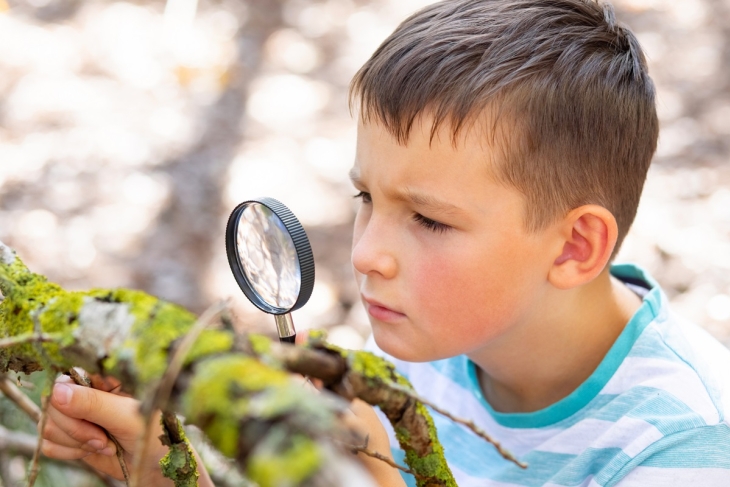The term “citizen science” refers to research in any field conducted with participation from the general public and/or amateur researchers—a way of crowd-sourcing data in more volume through observations or experiments conducted outside of a lab. Citizen science (CS) is utilized by NASA, NOAA, and other reputable research entities and was front and center during the solar eclipse earlier this year. CS also has the potential to allow K–12 students access to a broader range of scientific education than a typical classroom can offer, including data analysis and reporting. A new report looks at how two teachers have attempted to implement CS at the elementary level. It’s a limited picture, but this qualitative report does go inside the black box of the classroom, giving us some curricular ins and outs that are illuminating.
A group of researchers led by Sarah J. Carrier of North Carolina State University are engaged in a multi-year study of CS in elementary classrooms. Specifically, the development, deployment, and evaluation of curriculum support materials to help a group of teacher volunteers integrate two CS projects—one conducted by the National Weather Service, the other by a national nonprofit organization—into their classrooms. The new report is a case study of two fifth grade teachers implementing these materials in year three of the larger study. These were chosen for analysis because the CS project content aligned with the fifth grade science standards (weather and ecosystems) in the unnamed state(s) where the schools were located. They also connect science to other subjects such as English language arts (reading and writing informational text), math (manipulating data and graphing), and social studies (mapping). The primary questions: How do teachers incorporate CS projects in their classroom and in the schoolyard and how do teachers navigate their school contexts to include CS projects in their science instruction?
Both teachers were twenty-year veterans at Title I schools (meaning they had a high percentage of their students identified as economically disadvantaged). The schools posted years of low performance ratings in math, reading, and science, the last of which fell far below their state’s average regularly. The schools were located in rural communities in unidentified state(s) in the southeastern part of the country. Both teachers received one day of professional development training on the CS projects, as well as the researchers’ curricular materials. While these data come from year three of the larger study, it is important to note it was year one for actual classroom deployment. Data come from teacher-provided documentation of their use of the materials, along with data from classroom observations, instructional logs, teacher interviews, and student focus groups. No dates of implementation are provided.
One teacher, called “Taylor,” reported both internal and external barriers to full implementation of the curricular materials. As a result, her students had very limited exposure to CS. Barriers included skepticism about students’ abilities to understand and execute the more concrete scientific and mathematical operations required and her belief that “administrative pressure to prepare students for science assessments” meant that science activities not directly related to concepts and tested vocabulary took precedence over everything else during class time. Most lessons consisted of vocabulary review and test preparation, along with video clips and lectures. Taylor’s students did not participate in data analysis or share CS data with the science community. In fact, the totality of data from the research team suggested that her students went into the schoolyard to search for ladybugs—a single aspect of just one of the CS projects—for only eight minutes on a single day when an observer from the team was present.
The other teacher, called “Morgan,” reported similar concerns about her students’ abilities related to the CS projects. However, she told the researchers that “Just because they are low in math and reading does not mean they cannot do science. It just means that I’ve got to adjust.” Observation and interview data showed Morgan devoting significant time to reviewing both the curricular materials and the two CS projects themselves. In a mid-year interview, she reported that she had adapted the materials to her students’ abilities and interests. In the end, she documented student activity with the CS projects (checking a rain gauge, entering data, or doing class activities) during thirty-one weeks of the year. She reported needing to bolster her students’ knowledge of geography and topology and re-teaching how to set up and label a graph (all of which, she states, should have been learned in fourth grade). Morgan also taught her students how to enter rainfall data into a spreadsheet and upload it to the National Weather Service website. Most students ended the year able to do this work independently. In a focus group, one of Morgan’s students confirmed that reading a rain gauge all year helped them to learn about “the decimals to where we understand how much it is.” Another student reported, “We measure the precipitation by hundredths.”
Carrier and her team conclude that the commonalities of Morgan and Taylor’s student populations, school contexts, and CS curriculum supports demonstrate the importance of teachers in science education (at least in this limited context). They also believe they can refine their curriculum support materials to help various types of teachers. Taylor’s teaching style is described as “teacher-focused” and she herself as a “selective user” of curriculum, with many external influences limiting her ability to plan, adapt, and deploy curricular materials. Morgan’s teaching style, on the other hand, is described as “student-focused” and she as a “learner/modifier” type of curriculum user. While these definitions are likely too simplistic to have much applicability beyond the walls of their two specific classrooms, the detailed descriptions of science teaching and learning within those walls are valuable evidence of how quality instruction can be provided to the highest possible level. They are not to be ignored.
SOURCE: Sarah J. Carrier et al., “Citizen science in elementary classrooms: a tale of two teachers,” Frontiers in Education (October 2024).




